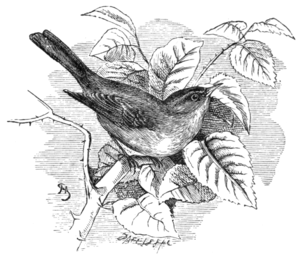of March, and continues them through the spring and summer till the end of August, as appears by my journals. The legs of the larger of these two are flesh-coloured; of the less black.

The Chiff-Chaff (Sylvia hippolais).
The grasshopper-lark began his sibilous note in my fields last Saturday. Nothing can be more amusing than the whisper of this little bird, which seems to be close by though at a hundred yards distance; and when close at your ear, is scarce any louder than when a great way off. Had I not been a little acquainted with insects, and known that the grasshopper kind is not yet hatched, I should have hardly believed but that it had been a locusta whispering in the bushes. The country people laugh when you tell them that it is the note of a bird. It is a most artful creature, sculking in the thickest part of a bush; and will sing at a yard distance, provided it be concealed. I was obliged to get a person to go on the other side of the hedge where it haunted, and then it would run, creeping like a mouse, before us for a hundred yards together, through the bottom of the thorns; yet it would not come into fair sight; but in a morning early, and when undisturbed, it sings on the top of a twig, gaping and shivering with its wings. Mr. Ray himself had no knowledge of this bird, but received his account from Mr. Johnson, who apparently confounds it with the
